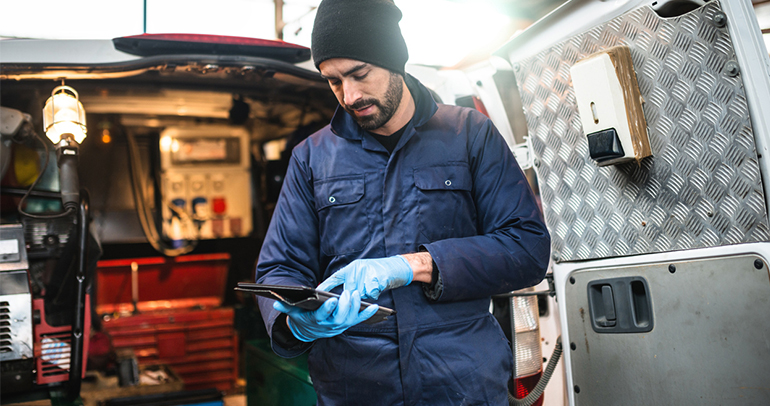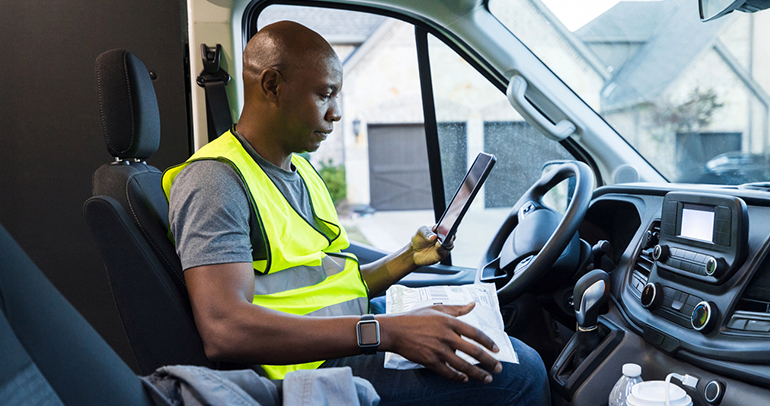
What if commercial vehicles could evolve around the businesses they serve?
The commercial vehicle industry isn’t just facing a tech upgrade—it’s undergoing a strategic reinvention. While passenger cars have evolved steadily into software-defined environments rich in infotainment and user experience, the commercial vehicle sector is only beginning to reckon with what this type of future means for its own operations and growth.
For fleet business managers, original equipment manufacturers (OEMs), upfitters, dealers and suppliers, the time has come to rethink not just the vehicle—but the very mindset surrounding it.
Why Overwhelmed Fleet Businesses Push Back Against Technology in Commercial Vehicles
In the consumer automotive world, innovation is becoming synonymous with experiences; over-the-air updates, immersive cockpits and infotainment systems dominate the conversation. We’re talking about everything from safety sensors and driver-assist systems to seamless connectivity and personalized entertainment zones.
But in the commercial vehicle and fleet space, success is measured differently—by uptime, efficiency and the ability to get the job done. What used to be purely mechanical machines are now increasingly becoming software-affected, infusing themselves in operations management and unlocking new features primarily through software.
So, while some fleet professionals see new technology as an advantage, it can come at the cost of greatly increased complexity. I spend my days talking with fleet business decision-makers and drivers about their jobs, and I’ve heard countless stories about how frustrating the sheer amount of tech is that’s onboard new vehicles. A $20 failed sensor hidden deep in a truck’s system shouldn’t mean days of downtime and thousands in lost productivity, but more often than not, it does. The cost in time, labor and productivity is staggering compared with the price of the failed part.
While OEMs and suppliers continue to push technology because it ultimately improves efficiency and control, many fleet businesses are overwhelmed by the added layers of diagnostics and cost. Decision-makers and drivers say the commercial vehicle sector doesn’t need flash—it needs functional evolution. The challenge and opportunity lie in balancing technological advances with real-world usability.
The good news is that as we increasingly move toward software-defined vehicles, there’s still lots of room for hardware-defined vehicles.
Modularity: The Smartest Commercial Vehicle Strategy You’re Not Using Yet
One of the biggest strategic opportunities ahead lies in reimagining commercial vehicles as modular platforms.
Historically, a commercial vehicle was purchased for a specific task and expected to serve that role for its entire lifecycle. But what if we could change that?
A delivery truck can become a mobile repair unit by swapping in different types of custom tooling and equipment. A van can move from an installation to sales role through adaptable shelving and reconfigurable storage. We’re not just talking about accessories—the platform would represent a new type of fundamental flexibility. And with that, dealers and upfitters could play an ongoing role in helping vehicles evolve with businesses, increasing value while reducing cost.
Modularity also opens the door to better standardization—creating systems that are more interoperable and serviceable across fleets. Systems that “just work” together make it easier to integrate new solutions without overhauling existing equipment. Imagine hardware components, storage units or even cab controls that can be swapped, upgraded or reconfigured with ease. This transforms how we think about asset longevity and efficiency.
This evolution in thinking is already happening. One national upfitter I spoke with questioned why anyone would bother with a body swap—many fleets flip trucks often and don’t want the hassle. But a city fleet manager pushed back, telling me they keep trucks for 10 to 15 years and run them into the ground. For them, swapping out a chassis while keeping a high-quality, long-lasting body is not only practical—it helps them avoid an expensive rebidding process. The upfit becomes an asset.
Winning in a National, Digital Commercial Vehicle Marketplace
The digital age has also blown open the boundaries of geography. With next-day delivery and seamless inventory tracking, fleets are no longer constrained to local suppliers. They search nationally—digitally—for the right parts, tools and support. There is a massive opportunity for any commercial vehicle player that can establish a strong online presence with real-time visibility, integrated systems and user-friendly portals. The key? Making it as easy for a customer 500 miles away to do business with you as one who’s five miles down the road.
Evolving Roles: From Seller to Strategic Partner for Commercial Vehicle and Fleet Businesses
This shift demands a new kind of relationship between dealers, suppliers, upfitters and their clients. It’s not just about selling a truck; it’s about becoming a strategic partner in that truck’s lifecycle. This consultative, entrepreneurial approach is where real opportunity lies. Fleet managers don’t just want someone who delivers a vehicle—they want someone who helps them run a smarter, more adaptable operation. Dealers that can offer guidance, training and effortless change position themselves as indispensable partners, not just vendors.
The Future of Commercial Vehicles Is Built on Flexibility
Ultimately, the shift in the commercial vehicle space isn’t just about products—it’s about mindset. A rigid, one-size-fits-all approach no longer works. The industry should look to embrace adaptability, modularity and the power of collaborative relationships.
This future isn’t about chasing shiny technology for technology’s sake. It’s about creating tools and strategies that match the realities of the commercial vehicle world—where time is money, reliability is gold and customization is a necessity. If we embrace this shift in thinking, we don’t just future-proof our businesses—we redefine what value looks like across the entire commercial vehicle industry.
The future of commercial vehicles won’t be won by chasing trends—it’ll be built by those who understand what fleet businesses really need and act boldly to deliver it. Our commercial vehicle and fleet industry experts partner with OEMs, dealers, upfitters and suppliers to turn insight into action—helping you stay ahead, solve smarter and lead with confidence.
If you have questions for our commercial vehicle and fleet industry experts, or want to learn more about Escalent’s Automotive & Mobility industry research and how we can build what’s next together, please complete the form below.
Want to learn more? Let’s connect.








